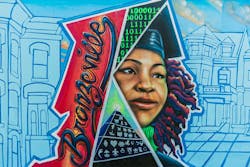Here comes the future: Bronzeville ‘microgrid cluster’ set to begin operating this year
Commonwealth Edison’s (ComEd) Bronzeville Community Microgrid is a much-watched project that, for the first time in the US, creates a utility microgrid cluster, in this case by linking with the Illinois Institute of Technology’s (IIT) microgrid.
This means that during an outage, IIT’s microgrid and the Bronzeville microgrid can both island from the grid and share power. Or, if necessary, either party can cut back on its nonessential loads and share power with the other. And that’s a big deal in the power world.
“The key here is this is the first utility-scale demo of a utility microgrid and customer microgrid working together in a real community serving more than 1,000 residential, commercial and public institution locations — including a public housing complex — leveraging solar and storage,” said Alexi Paaso, director of distribution planning for ComEd. “The big thing for us is the clustering capability, showing the ability of two microgrids to work together.”
Most recently, ComEd passed an important federal Department of Energy (DOE) milestone, successfully demonstrating the Bronzeville microgrid can island from the grid. At the same time, the project has encountered delays because of permitting requirements from the city of Chicago and has grappled with engineering challenges.
The Bronzeville microgrid consists of 750 kW of PV, a 500 kW/2 MWh battery energy storage system and 5 MW of dispatchable natural gas generation. The solar and storage are expected to keep the microgrid running for four hours.
Building a model microgrid cluster
When complete — sometime this year — the Bronzeville microgrid will be located in a residential and small business district of south Chicago.
Mohammad Shahidehpour, director of the Robert W. Galvin Center for Electricity Innovation at IIT, said the Bronzeville project — a partnership between owners of a behind-the-meter microgrid and a utility microgrid — should be a model for the rest of the country.
“You can have national labs, high schools, universities and other public entities with microgrids connected to utilities,” he said. During emergencies, they can island and send power to the utility. “When we island, we help the city,” said Shahidehpour.
The IIT microgrid has saved the institution $200,000 to $1 million annually, he said. Savings come from the use of solar and participation in demand response programs.
The Bronzeville microgrid recently completed the final testing required under a $4 million grant awarded by the DOE’s Solar Energy Technologies Office. The grant aims to study how microgrids can increase energy security and resilience and support the integration of clean energy.
Not a slam dunk
But getting to that point wasn’t necessarily a slam dunk. The project’s journey to date provides important lessons for others attempting similar projects.
For example, Allan Schurr, chief commercial officer at Enchanted Rock, which is providing the natural gas generator for the project, said he has been surprised by delays caused by the city of Chicago’s requirements. The city’s permitting process in the residential and small business neighborhood, he said, has been “arduous.”
“The city has a lot of ideas about how they want things to look,” Schurr said. “There are city regulations related to setbacks, wall or fence height, construction standards and the like.” The city doesn’t want the site to look too industrial, he added.
The cost of complying with the possible alternatives varies, depending on the options. The site is fairly large and the cost of mitigation measures can be expensive.
People tend to think of a power generating system in a neighborhood as large, dirty and noisy, Schurr said.
“With our microgrid, there is no smoke, there are no smokestacks, not a lot of noise and no odors. We have been educating local authorities over the last couple of months,” Schurr said. Part of the education process has involved pointing out local benefits. They include the fact that the microgrid will support the Bronzeville neighborhood during outages.
“The message is: ‘It’s not all the negative things you thought about, and look at all the positive things,’” said Schurr.
Schurr’s advice to utilities interested in similar projects: “Microgrids are new kinds of assets, and local authorities have to be part of the early discussions so they know what’s coming.”
“Microgrids are new kinds of assets, and local authorities have to be part of the early discussions so they know what’s coming.” — Allan Schurr, Enchanted Rock
Engineering lessons
The ambitious Bronzeville project has also encountered engineering challenges, especially in regard to islanding and synchronization, said Aleksandar Vukojevic, engineer and manager, smart grid for ComEd, which is a subsidiary of Exelon.
“When you take a look at any microgrid, hardware, software, communications, every time you separate from the grid, you need proper protection and control to have seamless islanding,” Vukojevic explained.
To ensure seamless islanding — islanding that microgrid customers aren’t aware of — microgrids need controllers and system protection. And with one microgrid on the ComEd side and another at IIT, ComEd had to figure out how best to synchronize the two.
To study and test these issues, the ComEd team performed simulations using the RTDS Technologies simulator, which allows simulations as if they’re happening in the real grid, said Vukojevic. The simulations focused in part on ensuring the power was secure and reliable.
The field test successfully demonstrated the microgrids’ abilities to island from the grid and then reconnect.
“The disconnecting and reconnecting to the grid was significant; there were no outages,” said Vukojevic.
The research and testing process required the team to be as flexible as possible, open to trial and error.
“My advice is to always have a Plan B and C in place and be ready to act on those. Many times we had to go back to the drawing board. Be resilient from the project standpoint,” said Paaso.
It’s also important for utilities interested in doing similar projects to understand that people from many different utility departments should be involved in the effort.
“Be prepared to engage many departments in your project,” said Vukojevic. “Don’t underestimate the number of engineers and levels of expertise you will need.” This project involves planning, liability and other departments. “Everybody has a touch point associated with this,” he said.
Bronzeville as a community of the future
The microgrid is part of ComEd’s Community of the Future initiative. This initiative aims to implement sustainable energy solutions in urban communities and provide education and access to resources to help communities become more resilient in the face of environmental challenges like climate change.
The Community of the Future effort includes electric vehicle (EV) charging stations and cybersecure extreme fast charging. ComEd is investigating cybersecure extreme fast charging because the faster the charger, the higher the likelihood of cybersecurity breaks, said Daniel Kushner, manager of smart grid and innovation for ComEd. A cybersecurity break might involve someone taking control of EV chargers, which could impact load, generation and balance of the microgrid.
“We want to make sure that if something like this happens, we can take control,” said Vukojevic.
In addition to the charging projects, the Community of the Future will include electric mobility projects to facilitate transportation of seniors, including access to businesses, said Kushner.
“Innovation and the type of work we’re doing is necessary to lead the way toward a more impactful energy system,” said Kushner.
Point of interest
Meanwhile, the project participants said that the Bronzeville microgrid cluster is attracting attention across the country.
“We’re getting interest from other utilities that have reached out about pockets in their service territory where a front-of-meter microgrid could help them,” said Schurr.
Added IIT’s Shahidehpour, “Being able to island the systems is of interest to everyone. Our objective is to cluster and help each other during outages.”
Interested in following the progress of microgrid cluster projects? Subscribe to the free Microgrid Knowledge Newsletter.
About the Author
Lisa Cohn
Contributing Editor
I focus on the West Coast and Midwest. Email me at [email protected]
I’ve been writing about energy for more than 20 years, and my stories have appeared in EnergyBiz, SNL Financial, Mother Earth News, Natural Home Magazine, Horizon Air Magazine, Oregon Business, Open Spaces, the Portland Tribune, The Oregonian, Renewable Energy World, Windpower Monthly and other publications. I’m also a former stringer for the Platts/McGraw-Hill energy publications. I began my career covering energy and environment for The Cape Cod Times, where Elisa Wood also was a reporter. I’ve received numerous writing awards from national, regional and local organizations, including Pacific Northwest Writers Association, Willamette Writers, Associated Oregon Industries, and the Voice of Youth Advocates. I first became interested in energy as a student at Wesleyan University, Middletown, Connecticut, where I helped design and build a solar house.
Twitter: @LisaECohn
Linkedin: LisaEllenCohn
Facebook: Energy Efficiency Markets


